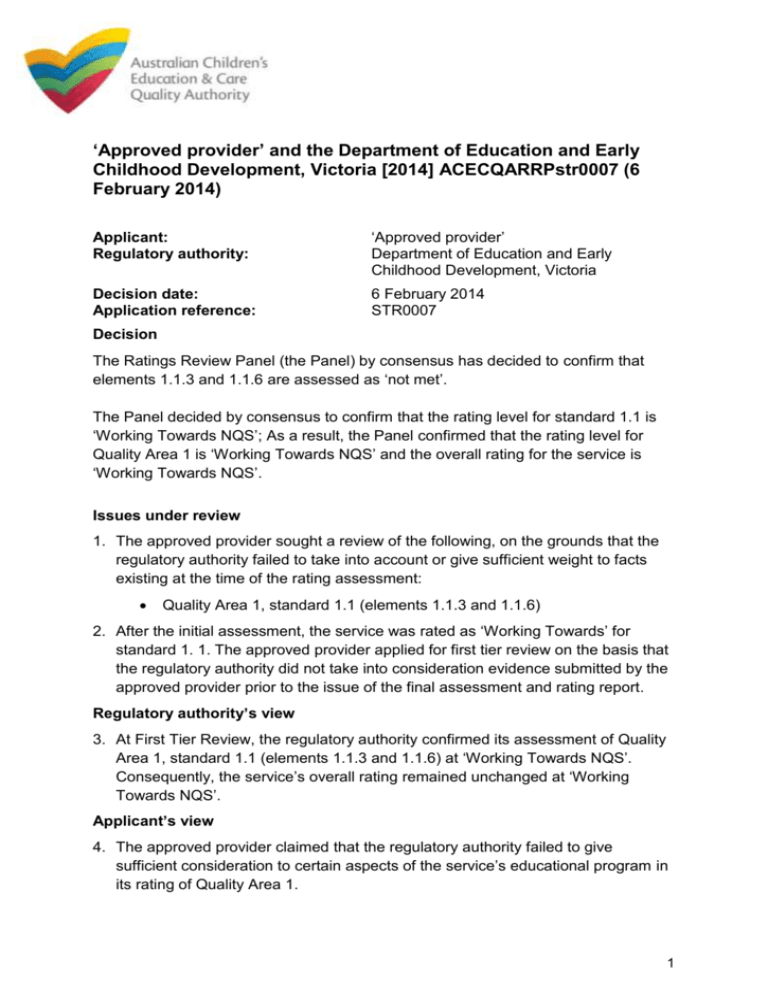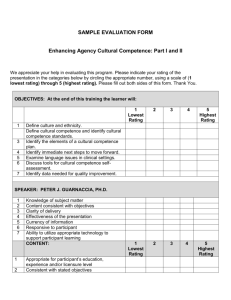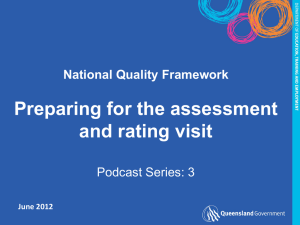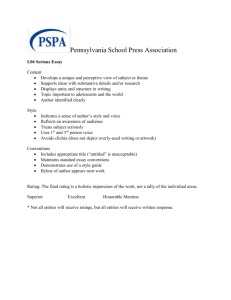Jolly Frog Kindergarten (STR0005) - Decision Notice
advertisement

‘Approved provider’ and the Department of Education and Early Childhood Development, Victoria [2014] ACECQARRPstr0007 (6 February 2014) Applicant: Regulatory authority: ‘Approved provider’ Department of Education and Early Childhood Development, Victoria Decision date: Application reference: 6 February 2014 STR0007 Decision The Ratings Review Panel (the Panel) by consensus has decided to confirm that elements 1.1.3 and 1.1.6 are assessed as ‘not met’. The Panel decided by consensus to confirm that the rating level for standard 1.1 is ‘Working Towards NQS’; As a result, the Panel confirmed that the rating level for Quality Area 1 is ‘Working Towards NQS’ and the overall rating for the service is ‘Working Towards NQS’. Issues under review 1. The approved provider sought a review of the following, on the grounds that the regulatory authority failed to take into account or give sufficient weight to facts existing at the time of the rating assessment: Quality Area 1, standard 1.1 (elements 1.1.3 and 1.1.6) 2. After the initial assessment, the service was rated as ‘Working Towards’ for standard 1. 1. The approved provider applied for first tier review on the basis that the regulatory authority did not take into consideration evidence submitted by the approved provider prior to the issue of the final assessment and rating report. Regulatory authority’s view 3. At First Tier Review, the regulatory authority confirmed its assessment of Quality Area 1, standard 1.1 (elements 1.1.3 and 1.1.6) at ‘Working Towards NQS’. Consequently, the service’s overall rating remained unchanged at ‘Working Towards NQS’. Applicant’s view 4. The approved provider claimed that the regulatory authority failed to give sufficient consideration to certain aspects of the service’s educational program in its rating of Quality Area 1. 1 Evidence before the panel 5. The panel considered all the evidence provided by the applicant and the regulatory authority. This included: o the application for second tier review and its attachments. o the assessment and rating instruments and final assessment and rating report o evidence available on the day of the assessment and rating visit o the Victorian regulatory authority’s findings on first tier review 6. The panel was also provided with advice from ACECQA on the elements, standard and Quality Area under review. The law 7. Section 151 states ‘Following a review, the Ratings Review Panel may: (a) confirm the rating levels determined by the Regulatory Authority; or (b) amend the rating levels’. 8. Information on the application of the National Quality Standard is available in the Guide to the National Law and Regulations and the Guide to the National Quality Standard available on ACECQA’s website. The facts 9. The assessment and rating visit took place on 9 and 10 September 2013. 10. Two officers were present at the service on 9 September 2013, a fully-trained authorised officer and an officer in training. 11. The approved provider received the assessment and rating decision on 4 November 2013. 12. The approved provider applied for first tier review on 15 November 2013 and received a decision on 27 November 2013. 13. ACECQA received the application for second tier review on 10 December 2013. 14. The service is a centre based long day care service with 27 approved places. Review of rating levels 15. The Ratings Review Panel (the Panel) considered each element and the standard under review in turn. 2 Standard 1.1 16. Standard 1.1 is that: ‘An approved learning framework informs the development of a curriculum that enhances each child’s learning and development’. 17. It is made up of six separate elements. two elements are under review. Element 1.1.3 18. Element 1.1.3 requires that: ‘The program, including routines, is organised in ways that maximise opportunities for each child’s learning’. 19. The authorised officer recorded evidence in the Assessment and Rating Instrument that ‘mealtimes are predictable. However during mealtimes children (Kinder) are hand fed i.e. given individual crackers’. The authorised officer also notes that children are encouraged to say ‘please’ and ‘thank you’. 20. The authorised officer notes under Standard 2.2 that ‘older children are waiting at the door to go outside’. 21. The officer in training notes in the Assessment and Rating Instrument that ‘children sit at tables inside for meals and are served by educators’. 22. The final Assessment and Rating Report states that ‘routines were not consistently utilised to support learning opportunities for children as educators in the pre kinder [room] used a tong to offer children one cracker at a time for morning tea’. 23. Further, the final Assessment and Rating Report also states that one child had asked for an extra cracker for his toy, which was not supported. 24. The regulatory authority reasoned in its findings at first tier review that the additional information provided by the approved provider at first tier review, in relation to the program and organisation of routines, was not supported by the authorised officer’s and officer in training’s observations on the day of the assessment and rating visit. 25. The regulatory authority also noted that, although the service subscribes to the Reggio Emilia approach to learning, educators ‘appeared to have a limited understanding of the approach and how to best organise the program to maximise children’s learning’. 26. The regulatory authority’s findings concluded that ‘meal routines were very structured, with limited engagement between children and educators’. The regulatory authority then noted that ‘[very structured meal routines and limited 3 engagement between children and educators] constrained opportunity for learning and at times led to children becoming frustrated’. 27. The approved provider’s submission at first tier review argues that predictable routines are used in the service’s bilingual program to teach children to recognise cues signalling intentional teaching. The submission also notes that the final Assessment and Rating Report failed to acknowledge the service’s weekly music session. 28. The approved provider addresses the regulatory authority’s statement in the final Assessment and Rating Report that ‘one child had asked for an extra cracker for his toy, which was not supported’ by explaining that the assessors did not observe the whole exchange. The approved provider states that following the child’s request, the educator involved switched positions with another educator who awarded the toy a cracker ‘when he said “please”. The approved provider states that the service ‘has been working tirelessly and closely with this particular child’s family to help this child express how he feels and thinks, learn what socially acceptable behaviours are, demonstrate good manners and to understand boundaries. 29. The regulatory authority’s findings acknowledged that table manners were discussed with children and that this was captured in the final Assessment and Rating Report. 30. The approved provider notes in its application for second tier review that the service delivers a daily bilingual enrichment program and a weekly music enrichment program which ‘maximise children’s involvement and engagement in learning’. The approved provider notes that no mention of these programs was made against element 1.1.3 in the final assessment and rating report. 31. The approved provider claims in its application for second tier review that the authorised officers’ ‘failure to sufficiently observe the educators’ performance in the bilingual and music learning spaces may have led the assessor to form an incomplete picture of [the educators’] competencies'. 32. The Panel acknowledged the approved provider’s music program but noted that there was not enough information to show how the program consistently supports children to maximise learning through the music program. 33. The Panel stated that it was unfortunate that the incident between the educator, the child and his toy, had been identified in the final assessment and rating report as the defining issue. The Panel also noted that the regulatory authority did not take the opportunity to follow-up on this incident with the educator. 4 34. Furthermore, the Panel also noted that it was also unfortunate that the regulatory authority used a lead-in statement in the final Assessment and Rating Report against element 1.1.3 which suggested the service had met this element. 35. The Panel discussed that while the focus on the incident between the educator, the child and his toy was unfortunate, it was clear in the Assessment and Rating Instruments and the final Assessment and Rating Report that there were other examples of when routines were not consistently utilised to support learning opportunities for children. 36. The Panel agreed that notes in the Assessment and Rating Instruments of instances in which children were waiting to go outside and where children were expected to sleep and eat and the same time indicated that this was usual practice. 37. The Panel reviewed the material on assessing inconsistent quality in the ACECQA Guide to Assessment and Rating for Regulatory Authorities and concluded that inconsistencies in quality were not isolated and that a range of examples where children’s opportunities for learning were not maximised supported a rating of ‘not met’. 38. Subsequently, the Panel confirmed the rating for element 1.1.3 at ‘not met’. Element 1.1.6 39. Element 1.1.6 requires that: ‘Each child’s agency is promoted, enabling them to make choices and decisions and influence events and their world’. 40. The officer in training notes in the Assessment and Rating Instrument that a bilingual program and a music program exist. The officer in training details the music program noting that all children attend the music program and that children are given props and instruments to play with. The officer in training notes that ‘one pre-kinder child spent time in (sic) bike while [the] music session [was] on – own choice to leave and go play was supported’. 41. The authorised officer also mentions the music program in her notes against standard 1.2 also noting that a child was allowed to leave. 42. The authorised officer notes some examples, against standard 2.1, of children being required to be involved in activities they do not wish to participate in. Reference is made to children being required to sit in a high chair after indicating that they do not want to sit at the table. Another reference is made to an educator trying to feed a child who appears to indicate that they wish to sleep. The child turned their head when offered food. 5 43. The authorised officer also notes under standard 2.2 an instance in which a child was moved away from water and paint and had their apron removed without warning. 44. The authorised officer also notes against standard 2.2 that some children are asleep while others are in the play room and that educators offer children choices about which part of the sandwich they would like to eat and what fruit they would like. 45. Notes from the authorised officer against standard 3.2 mention an instance in which an educator refused to allow a child to pull a toy from a tub outside explaining that there were already lots of toys outside. 46. Notes from both the authorised officer and the officer in training against standard 3.3 cite examples of educators showing children how to water the garden and praising children who are watering the garden and painting. Reference is also made to a self-help table for children containing water bottles, tissues, handwashers etc. 47. The authorised officer notes at the end of the Assessment and Rating Instrument appear to question children’s agency with the comments ‘felt some led; all sit together; all out together’. 48. The final Assessment and Rating Report states that ‘educators sometimes encouraged children to make choices and some decisions, this was evident in all rooms’. The report also states that ‘children’s agency was not consistently considered throughout the service and this was evident when a child wanted to open boxes in the outdoor area… this was however discouraged by an educator as there were enough toys in the outdoor space’. 49. The regulatory authority reasoned in its findings on first tier review that the additional information provided by the approved provided on first tier review, in relation to the service’s promotion of children’s agency, was not supported by the authorised officers’ observations on the day of the assessment and rating visit. 50. The regulatory authority noted that there was no consistency in children’s choice in activities, the ‘children ate together, in the pre-kinder room slept at the same time; children outside at the same time and lined up at the door.’ The same notes suggest that the choice to sleep or not was not consistent in the kinder room. 51. The regulatory authority concluded in its findings on first tier review that ‘educators were observed regularly directing children’s play rather than allowing children to determine their own play and leisure experiences. The organisation of specific indoor and outdoor activities [also] reduced children’s opportunities for influencing their environment and engaging for extended periods in either indoor or outdoor play’. 6 52. The approved provider discusses practices which promote children’s agency which it claims are embedded at the service. The approved provider discusses in detail the example cited in the authorised officer’s notes against standard 3.2 in which a child’s request for a toy was refused. In this instance, the approved provider claims the refusal to allow the child to obtain another toy was ‘an opportune moment to encourage intention in his action’. The approved provider explains that this child has behaviour management issues. 53. The approved provider notes in its application for second tier review that the service’s ‘programs promote children’s agency in vital ways by enabling them to develop social, emotional and linguistic skills’. 54. Further, the approved provider asserts that ‘had these elements of [the service’s] program been given sufficient weight… [the authorised officers] would have noted abundant examples of educators skilfully supporting children’s agency and learning through intelligently drawing on a range of pedagogies’. 55. The Panel found that observations of practice are critical when collecting evidence against many elements and that in many instances, it is observed practice and not paperwork which will greatly inform an authorised officer’s assessment. 56. The Panel noted that while the regulatory authority’s observations of inconsistent practice were quite small, collectively they provided a reasonably strong impression. 57. The Panel agreed that there were some great examples of the promotion of children’s agency recorded in the Assessment and Rating Instruments but that these practices were not consistently observed throughout the day of the assessment and rating visit. 58. The Panel again noted that it was unfortunate that the regulatory authority had not taken the opportunity to follow-up on the inconsistent promotion of children’s agency through discussion with the educators at the service. 59. The Panel concluded that the reliance of the rating of this element on the observations of the regulatory authority was appropriate given the nature of the element. 60. Subsequently, the Panel confirmed that rating for element 1.1.6 at ‘not met’. 7








